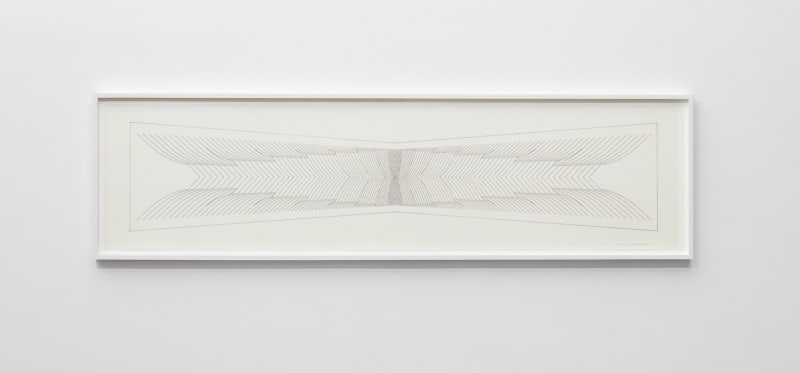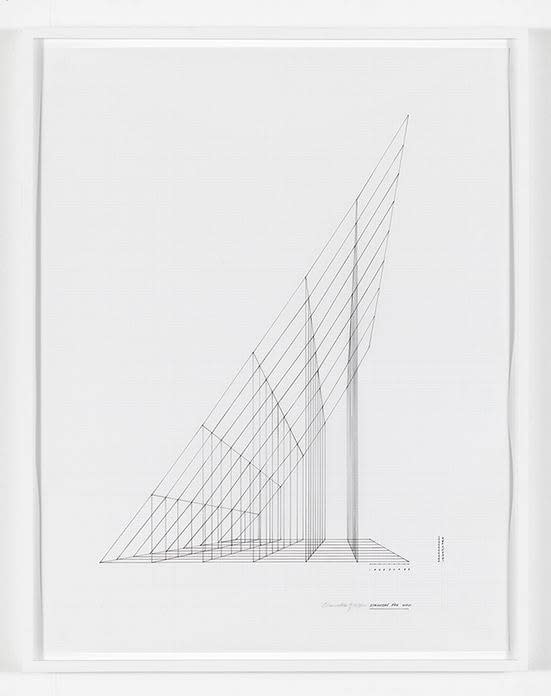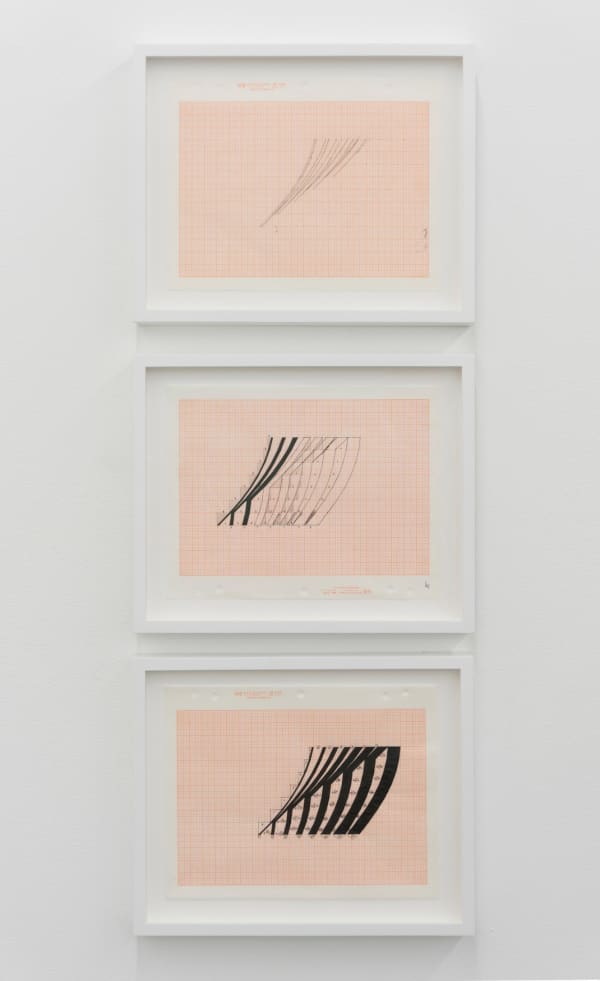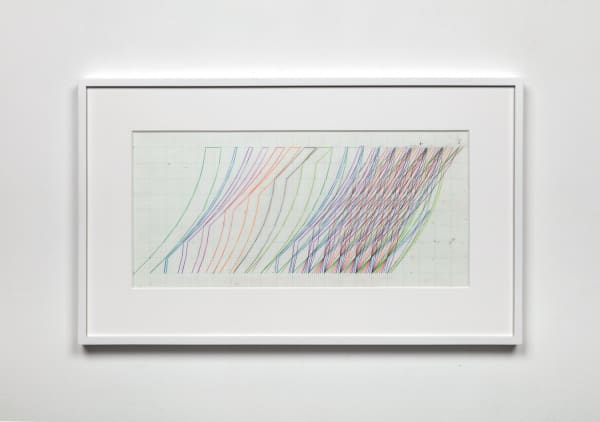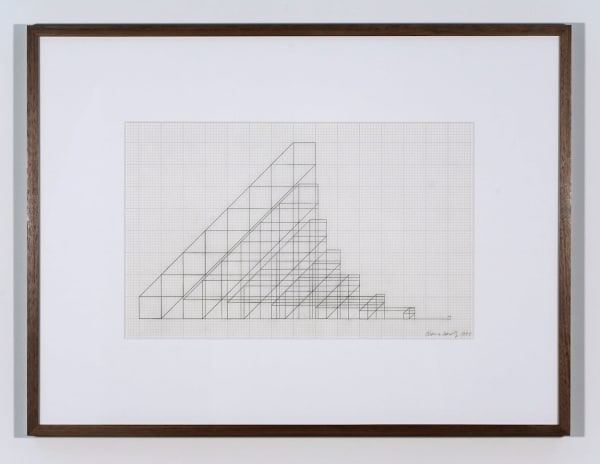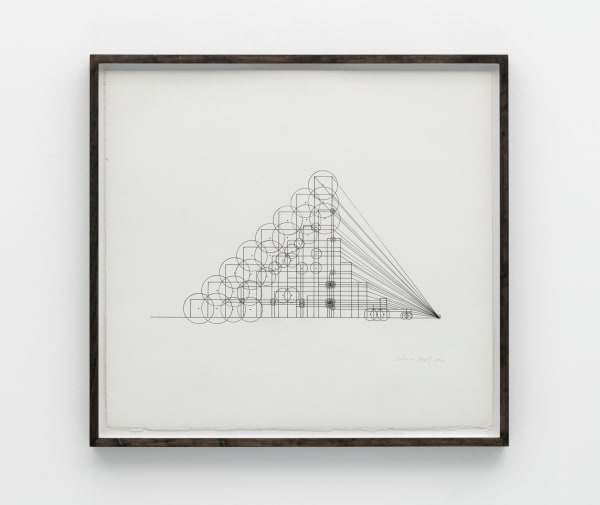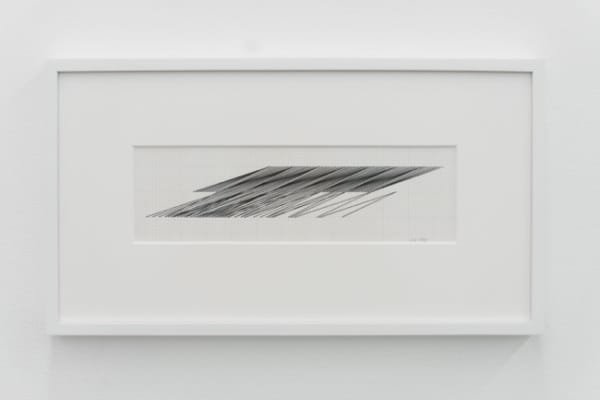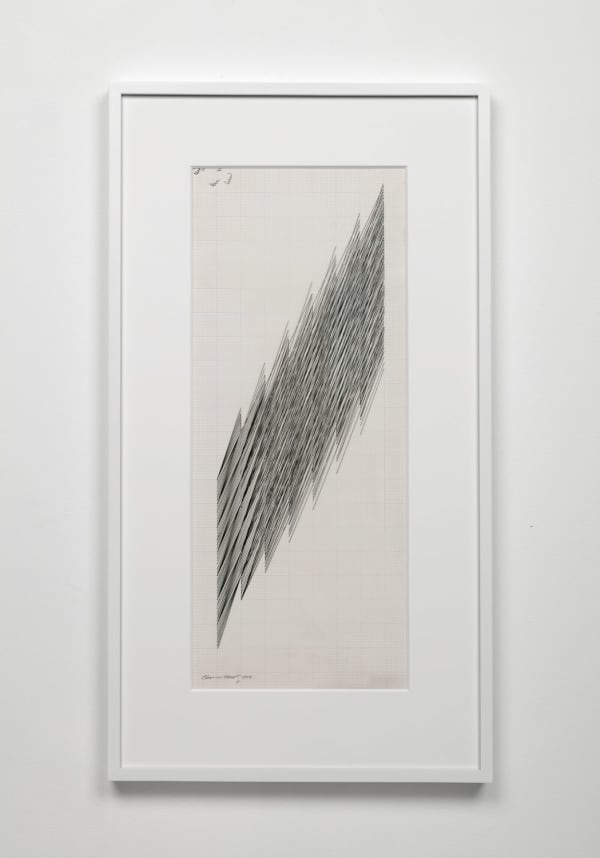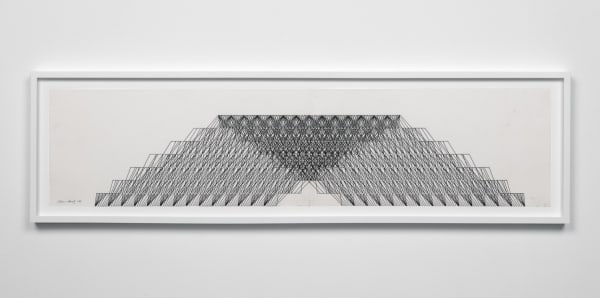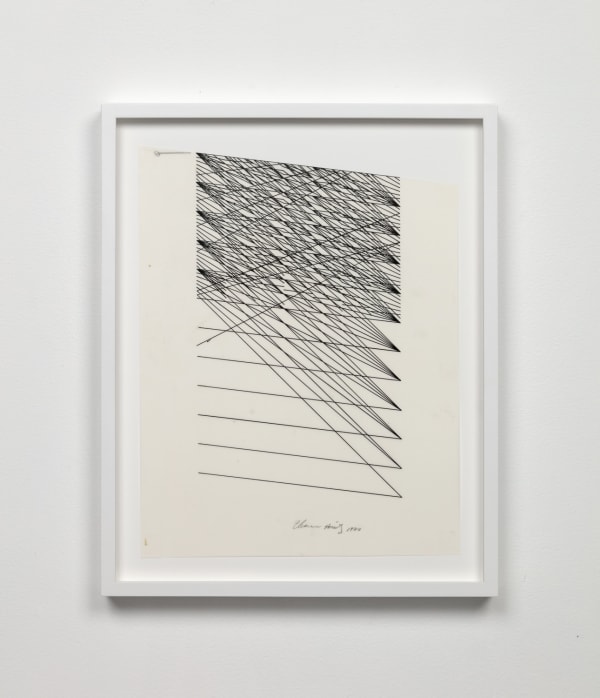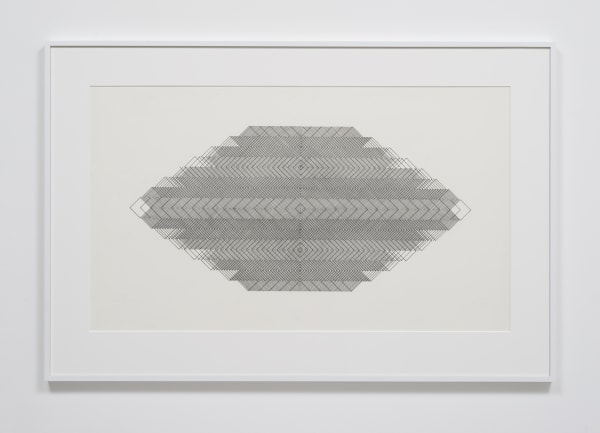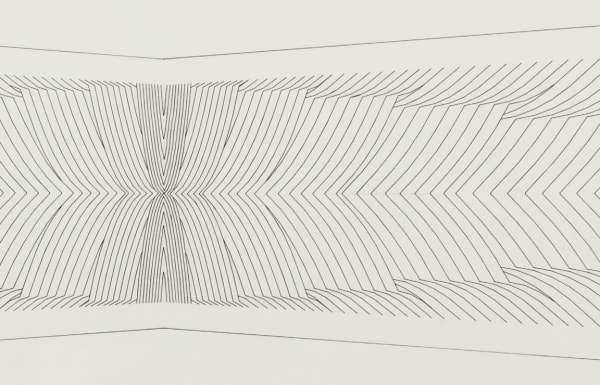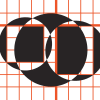Channa Horwitz: Structures
I feel that through chance comes structure, or that if chance plays out long enough it will become structure. That if we cannot see the structure in chance we are too close to see it. The theory behind my work is that through structure comes an apparent chance. If structure plays out long enough it will appear to be chance… The cycle of life as I see it is circular. The beginning and ending are only one step away from each other.
Channa Horwitz, 2005
François Ghebaly is proud to present Structures, an exhibition of intricate, previously unseen drawings by the late Los Angeles artist Channa Horwitz. The exhibition focuses on the period from 1975 through 1985, a time in which Horwitz embarked on a new series called Structures that disassembled and analyzed her previous work, leading to new discoveries and opening fresh pathways that would guide the artist’s practice in the decades following. The works from the Structures series are presented alongside the pieces they would inspire, including several large scale and multipart works from the period.
Known for her tightly controlled approach to geometric abstraction, Channa Horwitz famously devised a drawing system in the late 1960s called Sonakinatography in which sound, motion, and space are tracked using beats of time graphed on eight-to-the-inch square grids. In each, the numbers one through eight are represented graphically by color or symbol and plotted according to an initiating set of rules that ultimately created her compositions. Sequencing, seriality, and iteration are all key dynamics in these works.
This notation system assumed a generative power within Horwitz’s practice, with new series spawning from existing ones like the branching of an evolutionary tree. With each alteration of the starting variables in the system, a new body of work arose. In some, multiple sequences are superimposed into a single drawing, as in the works from the Canon series. In others, like the works from the series Slices, sequences are visualized rotating in space and cross sectioned, “as if it was the front slice in a loaf of bread,” as she put it. Horwitz built her visual systems with an exacting rigor, yet was consistently guided by an openness to new possibilities embedded within her existing architectures.
The exhibition centers around the Structures, a series Horwitz began in the mid 1970s that reveals this openness. Describing this diverse body of work, Horwitz called the drawings “dissections.” Taking her layered, complex compositions of the previous decade as her starting point, she isolated specific passages to better understand the operations that lay beneath. As a result, these works act as keys that reveal the logics of the larger works also in the exhibition. In pieces like Angle Structure (1980) and Canon Untitled (c. 1982), densely packed lines with variable slopes intersect to form emergent patterns. These works give a preface to the large Canon and Moiré works that would populate Horwitz’s output through the 1980s. Exhibited here for the first time, these Structures provide valuable insight into how Horwitz built her mesmerizing and visually dense mid-career works.
The exhibition continues with a set of multipart works that exemplify the extent of the artist’s depiction of movement through seriality. Variation and Inversion on a Rhythm IV (1976) operates as a single work composed of one hundred and twelve individual drawings depicting the transit of forms across numerous stepwise transformations. It is paired with Variations and Inversions on a Rhythm 14 Parts #2 (1975), a similar work with fourteen elements. What at first appears to be gently curving forms are shown to consist of straight lines on colored graph paper whose slopes are determined by values that rise and fall from sheet to sheet. The resulting works illuminate the scale of Horwitz’s project, which takes on a computational magnitude in its representation of rhythm and time.
Eulogizing Horwitz in the pages of Artforum, the writer Chris Kraus noted that “it is becoming ever more apparent that Horwitz’s simultaneous pursuit of extreme mathematical rigor and utter aleatory openness—when most artists of her generation chose one of the above—constitutes a unique vision,” one that combined an embrace of both abstract rules and the curious wanderings of lived experience. Indeed, the artist revealed in Structures is one who, searching for essences, found guidance in a simple yet vast observation, that, as she put it, “if I wanted to experience freedom, I need to reduce all of my choices down to the least amount.”.
Channa Horwitz (b. 1932, d. 2013) lived and worked in Los Angeles. Recent solo exhibitions include those at Contemporary Art Gallery, Vancouver; Lisson Gallery, New York; Raven Row, London; KW Institute for Contemporary Art, Berlin; Air de Paris, Paris; Ghebaly Gallery, Los Angeles; Aanant & Zoo, Hamburg; and Solway Jones, Los Angeles. She was awarded a Guggenheim Fellowship in 2013 and her work has been exhibited in numerous institutions and group shows including the Museum of Modern Art, New York; Museum Tinguely, Basel; Centro de Arte Contemporânea Inhotim, Brazil; Los Angeles County Museum of Art; the 2014 Whitney Biennial, New York; the 55th Venice Biennale; Made In L.A. 2012, Hammer Museum, Los Angeles; Pacific Standard Time, Los Angeles; New Museum, New York; and Kunsthalle Dusseldorf, among others. Horwitz’s work resides in significant public collections including the Museum of Modern Art, New York; Hammer Museum, Los Angeles; Getty Research Institute, Los Angeles; Los Angeles County Museum of Art; and National Gallery of Art, Washington, D.C.
-
 Channa Horwitz, 8 Part Fugue III, 1981
Channa Horwitz, 8 Part Fugue III, 1981 -
 Channa Horwitz, 8 Shapes Explanation for Flowing and Numbers, 1980
Channa Horwitz, 8 Shapes Explanation for Flowing and Numbers, 1980 -
 Channa Horwitz, Structure, n.d.
Channa Horwitz, Structure, n.d. -
 Channa Horwitz, Structure for Slices, 1978- 2010
Channa Horwitz, Structure for Slices, 1978- 2010 -
 Channa Horwitz, Structure for Wing, 1979/2011
Channa Horwitz, Structure for Wing, 1979/2011 -
 Channa Horwitz, Slices, c. 1977
Channa Horwitz, Slices, c. 1977 -
 Channa Horwitz, Slices Structure, n.d.
Channa Horwitz, Slices Structure, n.d. -
 Channa Horwitz, Canon Untitled, c. 1982
Channa Horwitz, Canon Untitled, c. 1982 -
 Channa Horwitz, Variation and Inversion on a Rhythm IV, 1976
Channa Horwitz, Variation and Inversion on a Rhythm IV, 1976 -
 Channa Horwitz, Variation and Inversion on a Rhythm 14 Parts #2, 1975 - 2011
Channa Horwitz, Variation and Inversion on a Rhythm 14 Parts #2, 1975 - 2011 -
 Channa Horwitz, Eight Structures #3, 1980
Channa Horwitz, Eight Structures #3, 1980 -
 Channa Horwitz, Canon #8, 1983
Channa Horwitz, Canon #8, 1983 -
 Channa Horwitz, Canon Series #10, Black/White, 1982
Channa Horwitz, Canon Series #10, Black/White, 1982 -
 Channa Horwitz, Squares, 1988
Channa Horwitz, Squares, 1988 -
 Channa Horwitz, Untitled Structure, 2010
Channa Horwitz, Untitled Structure, 2010 -
 Channa Horwitz, 8 Part Fugue II, 1981
Channa Horwitz, 8 Part Fugue II, 1981 -
 Channa Horwitz, Canon Structure, n.d.
Channa Horwitz, Canon Structure, n.d. -
 Channa Horwitz, Structure, 1984
Channa Horwitz, Structure, 1984 -
 Channa Horwitz, Angle Structure, 1980
Channa Horwitz, Angle Structure, 1980 -
 Channa Horwitz, Canon "Red Violet Wrong", c. 1982
Channa Horwitz, Canon "Red Violet Wrong", c. 1982 -
 Channa Horwitz, Canon Untitled, c. 1983
Channa Horwitz, Canon Untitled, c. 1983 -
 Channa Horwitz, Canon Untitled, c. 1983
Channa Horwitz, Canon Untitled, c. 1983 -
 Channa Horwitz, Canon Untitled, c. 1982
Channa Horwitz, Canon Untitled, c. 1982 -
 Channa Horwitz, Untitled Fragment from Canon #10, c. 1982
Channa Horwitz, Untitled Fragment from Canon #10, c. 1982 -
 Channa Horwitz, Canon Fragment, c. 1982
Channa Horwitz, Canon Fragment, c. 1982 -
 Channa Horwitz, Canon Fragment, 1980
Channa Horwitz, Canon Fragment, 1980 -
 Channa Horwitz, Canon Diamond – Two Halves, 1982
Channa Horwitz, Canon Diamond – Two Halves, 1982 -
 Channa Horwitz, Canon Diamond, 1986
Channa Horwitz, Canon Diamond, 1986
